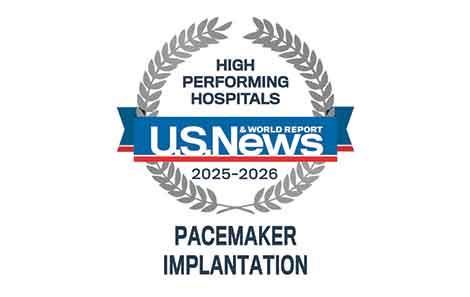Pacemakers
Make an Appointment
For the Charlottesville area:
For Northern Virginia:
Finding out your heart has a problem keeping on beat brings lots of questions and concerns. You're worried about what it means for your future. And you want to know what treatments work best. A pacemaker is a kind of heart device that helps your heart stay on rhythm. It lives close to your heart and is put in using a minor surgery.
You usually need a pacemaker if you have an abnormally slow heart rate with these symptoms:
- Fatigue
- Shortness of breath
- Lightheadedness
- Passing out
This slow heart rate can come from a problem with your heart's sinus node (its natural pacemaker). You may also have problems with how electrical signals travel through other parts of the heart.
How Do Pacemakers Help Heart Rhythm Issues?
A pacemaker is implanted through a minor surgery and can help with an abnormally slow heart rate with fatigue, shortness of breath, lightheadedness, or passing out. See Pam Mason, MD, discuss what pacemakers can do for you.
a pacemaker is an implantable device
that treats very slow heart rhythm
abnormalities there are a variety of
reasons why patients heart rhythms can
get too slow but a pacemaker is a small
implantable device that prevents
patient's heart rates from getting too
low and even can help give them heart
rate response when they're exercising or
exerting themselves they usually go
under the skin of the left shoulder and
they watch patient's heart rhythms all
the time and when they the device
notices that the patient has a slow
heart rhythm it will begin to pace and
prevent them from getting too low our
heart rates there are a variety of
patients who can benefit from pacemakers
many of our patients are elderly
although not all of them but any patient
who has heart rhythms that are slow
enough that it's putting them at risk
for dizziness passing out or just having
low energy and fatigue can benefit from
a pacemaker the wonderful thing about
modern pacemakers is they don't limit
patients lifestyle at all pacemakers are
designed to get patients out there and
doing all the things that they want to
do and there's really very little
limitation that patients who have
pacemakers experienced the University of
Virginia pacemaker clinic provides
comprehensive care for these devices we
don't just implant them we also follow
them make sure that the the programing
of the device is adequate and should the
patient have any problems with their
pacemaker we're fully set up to deal
with any possible complications that can
occur
you

High-Performing In Pacemaker Placement
5 of our heart, vein, and artery treatments received the highest possible rating from U.S. News & World Report, including pacemaker implantation (ranked as "high performing").
How We Implant a Pacemaker
- Your doctor implants a pacemaker under the skin in the upper part of your chest, near your left shoulder.
- Before the procedure, your doctor cleans the area to prevent infection.
- You're given medicine to go to sleep (sedated) and you'll stay asleep through the procedure.
- We numb the skin below your collarbone and a small cut (called an incision) is made (about 1.5 inches long).
- A space is made beneath the skin for the pacemaker, which is about the size of a half-dollar.
- Next, one or more wires, or leads, are put into a vein beneath your collarbone. This vein connects with the heart and allows the wire(s) to be passed into your heart.
- Using these wires, the pacemaker monitors your heart’s electrical system and speeds it up (stimulates it) if the heart rate becomes too slow.
- The wires are then connected to the pacemaker and it is placed under the skin.
- Your doctor closes the incision with sutures.
- After we insert your pacemaker, you'll have to stay overnight for monitoring.
- The following day, we'll take an X-ray of your chest.
Recovery
Your doctor may give you a list of restrictions after you've gotten your pacemaker, including:
- Temporarily, no reaching overhead with the arm on the same side as the pacemaker
- Keeping the incision dry for 48 hours
- Avoiding heavy lifting for 2 months
We'll ask you to return to the clinic 2 weeks after pacemaker placement so we can check the incision and the pacemaker. After that, we usually check the device every 3 months, either in the clinic or remotely by telephone or internet.